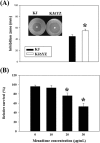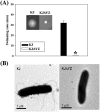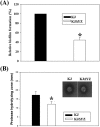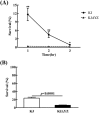The SmeYZ efflux pump of Stenotrophomonas maltophilia contributes to drug resistance, virulence-related characteristics, and virulence in mice
- PMID: 25918140
- PMCID: PMC4468721
- DOI: 10.1128/AAC.00372-15
The SmeYZ efflux pump of Stenotrophomonas maltophilia contributes to drug resistance, virulence-related characteristics, and virulence in mice
Abstract
The resistance-nodulation-division (RND)-type efflux pump is one of the causes of the multidrug resistance of Stenotrophomonas maltophilia. The roles of the RND-type efflux pump in physiological functions and virulence, in addition to antibiotic extrusion, have attracted much attention. In this study, the contributions of the constitutively expressed SmeYZ efflux pump to drug resistance, virulence-related characteristics, and virulence were evaluated. S. maltophilia KJ is a clinical isolate of multidrug resistance. The smeYZ isogenic deletion mutant, KJΔYZ, was constructed by a gene replacement strategy. The antimicrobial susceptibility, virulence-related physiological characteristics, susceptibility to human serum and neutrophils, and in vivo virulence between KJ and KJΔYZ were comparatively assessed. The SmeYZ efflux pump contributed resistance to aminoglycosides and trimethoprim-sulfamethoxazole. Inactivation of smeYZ resulted in attenuation of oxidative stress susceptibility, swimming, flagella formation, biofilm formation, and secreted protease activity. Furthermore, loss of SmeYZ increased susceptibility to human serum and neutrophils and decreased in vivo virulence in a murine model. These findings suggest the possibility of attenuation of the resistance and virulence of S. maltophilia with inhibitors of the SmeYZ efflux pump.
Copyright © 2015, American Society for Microbiology. All Rights Reserved.
Figures






References
-
- Poole K. 2008. Bacteria multidrug efflux pumps serve other functions. Microbe Mag 3:179–185.
Publication types
MeSH terms
Substances
LinkOut - more resources
Full Text Sources

